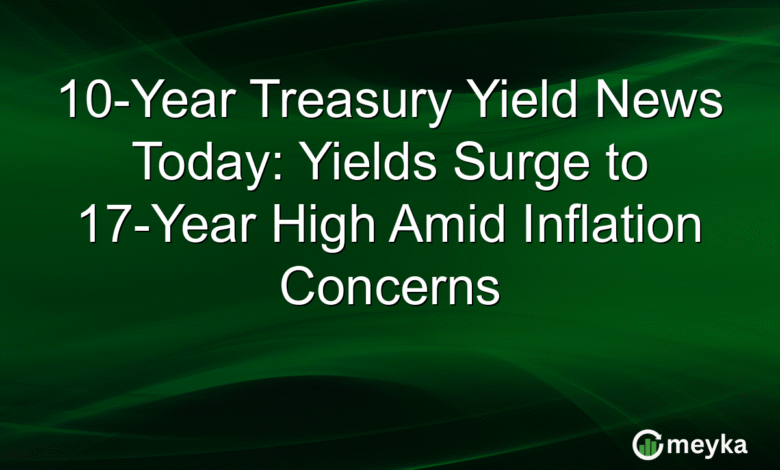10-Year Treasury Yield News Today: Yields Surge to 17-Year High Amid Inflation Concerns

The 10-year Treasury yield has surged to its highest since 2008, reaching levels not seen in 17 years. This sharp rise comes after hotter-than-expected inflation data, which has fueled speculation that the Federal Reserve may maintain higher interest rates for an extended period. This change in the 10-year Treasury yield has significant implications for the US bond market, equity markets, and borrowing costs, leaving investors and analysts re-evaluating their strategies.
Understanding the Surge in 10-Year Treasury Yields
Recent data revealed that inflation is hotter than anticipated. The immediate market reaction was a swift surge in the 10-year Treasury yield, breaching 4.85%, the highest since 2008. This leap reflects growing concerns that the Federal Reserve might keep interest rates elevated longer than expected. This movement is causing a ripple effect across various financial markets.
The 10-year Treasury is often viewed as a barometer for long-term interest rates. As yields rise, the cost of borrowing for governments, businesses, and consumers typically increases. This shift often leads to broader economic impacts, affecting everything from mortgage rates to corporate bonds.
Impact on US Bond Market and Equity Markets
The US bond market is seeing significant volatility as investors adjust to these new yield levels. Higher yields mean lower bond prices, and this has triggered substantial re-pricing across the bond market. Analysts highlight that these developments are pressing investors to reconsider their risk exposure.
Equity markets have also responded with increased volatility. Investors are shifting focus from growth stocks, which are sensitive to rising rates, towards value stocks, which often perform better in high-rate environments. This reallocation reflects changing investor sentiment as they navigate this interest rate outlook.
Federal Reserve Policy and Interest Rate Outlook
The Federal Reserve’s response to persistent inflation plays a critical role in the current rate environment. As inflation remains stubbornly high, expectations are building that the Fed might not relax its policy soon. This situation places more pressure on the Federal Reserve to carefully balance controlling inflation without stifling economic growth.
For investors, understanding the Fed’s potential actions is key. Staying updated on economic indicators and Fed announcements can provide crucial insights into the future direction of the 10-year Treasury yield and broader market conditions.
Final Thoughts
The recent rise in the 10-year Treasury yield underscores the complexities of the current economic climate, driven by inflation concerns and Federal Reserve policies. For investors, this means reassessing portfolios and strategies, especially regarding interest-sensitive investments. Staying informed about the Federal Reserve’s actions and market trends will be essential in navigating these turbulent times. Meyka, an AI-powered platform, offers real-time financial insights that can help investors make informed decisions amidst such fluctuations. Looking ahead, the dynamics of the 10-year Treasury yield will continue to be a critical factor for financial markets and economic stability.
FAQs
The 10-year Treasury yield hit a 17-year high due to unexpected inflation data, prompting speculation that the Federal Reserve might keep interest rates elevated longer. This has led investors to reassess risk and adjust financial strategies accordingly.
A rise in the 10-year Treasury yield impacts the economy by increasing borrowing costs for government, businesses, and consumers. This can lead to higher mortgage rates, expensive corporate borrowing, and potentially dampen economic growth.
Investors should closely monitor Federal Reserve policies and economic indicators. Diversifying and reallocating portfolios towards less rate-sensitive investments could help manage risk in a high-yield environment.
Disclaimer:
This is for information only, not financial advice. Always do your research.





